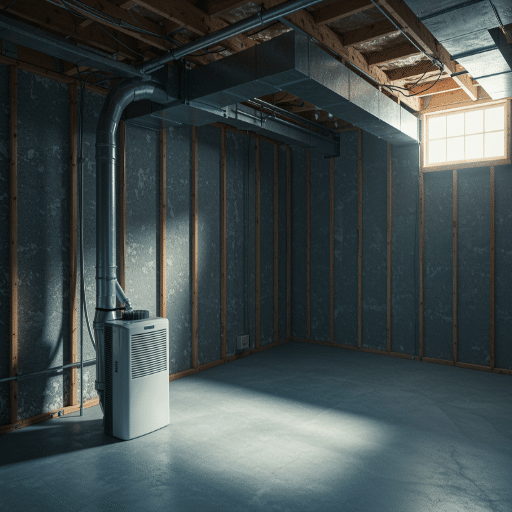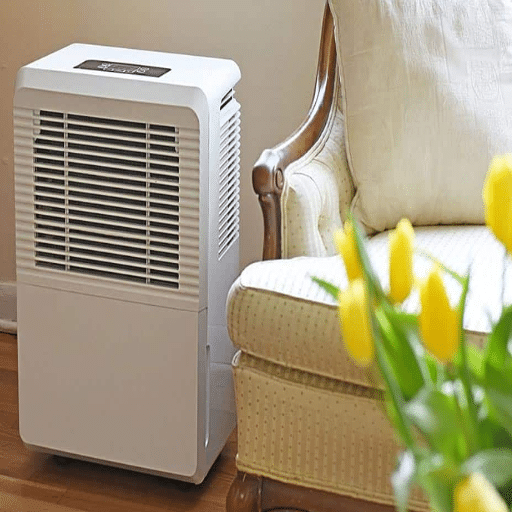Portable dehumidifiers are necessary for controlling indoor air quality, especially in places with high moisture content. These appliances automatically remove excess water vapor from the air, inhibiting the growth of bacteria, mold, and mildew and increasing comfort levels. This article elaborates on the principles governing how such appliances operate, their mechanical structures, and the models currently available in the fulfilling market. Thus, if you want to learn how to control humidity or buy dehumidifiers, you can read this guide to help you make a sound decision.
What is a portable dehumidifier, and why do I need one?
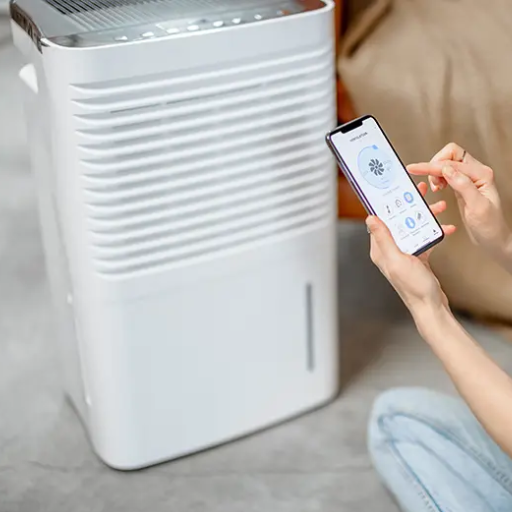
A portable dehumidifier is a small, light, moveable unit that eliminates and controls humidity. It works by sucking in moist air, chilling it, extracting the moisture, and releasing dry air back into the room. People can benefit from this device by avoiding mold exposure, musty odors, and condensation, which, as a result, fosters a healthier and more comfortable environment for people. On the other hand, portable dehumidifiers work efficiently in humid conditions like a basement or a bathroom, and people with allergies or respiratory issues caused by excess moisture in the air can benefit greatly as well.
Understanding the basics of portable dehumidifiers
A dehumidifier is an excellent tool for reducing moisture in an area, ensuring that the air you breathe is healthy and comfortable, and preventing mold growth. This versatile technological appliance can effectively combat high humidity levels and is indispensable in regions with high moisture in the air. An affordable solution, the dehumidifier can be efficiently employed in multiple ways, including indoor spaces such as basements, attics, and offices.
Newer models of dehumidifiers come with numerous energy-efficient features, such as automatic shut-off, which efficiently shuts off the device when the water level is too high. Moreover, for ease of use, these devices come with user-friendly interfaces while boasting a built-in hygrometer and improved air quality by removing dust and pollen, ensuring a comfortable and healthy one.
Signs you may need a dehumidifier in your home
In my opinion, I can pinpoint signs indicating a need for a dehumidifier. To begin with, humidity levels exceeding 50% can indicate that dehumidifiers are your only hope. Furthermore, musty odors combined with condensation on windows, peeling of paints, mold, or mildew odors also signal potential trouble. Moreover, incessant coughs, wheezes, or allergy attacks among family members may mean spores or other airborne pathogens run rampant. Timely action can ensure you prevent harm and maintain valued indoor air quality.
Benefits of using a portable dehumidifier
Indoor humidity can be effectively regulated with the help of portable dehumidifiers and has numerous benefits for health and economic purposes. Dry air combats mold contamination in body portions and furniture by removing excess moisture. Furthermore, asthma sufferers are advantaged when dry air limits the life cycle of dust mites and other allergens.
These devices can also assist in eliminating damp and musty smells, improving the environment and making it more pleasant. Additionally, the removal of unwanted air moisture contributes to increased machine efficiency; in this instance, air conditioning systems can better cool spaces, which can decrease energy expenses. Due to its advanced technology, it is possible for users in various situations, for instance, to resolve specific issues with sitting rooms, W.C.s, or laundries. The scarcity of such problems will sustainably aid the property and the people’s health.
How does a portable dehumidifier remove moisture from the air?
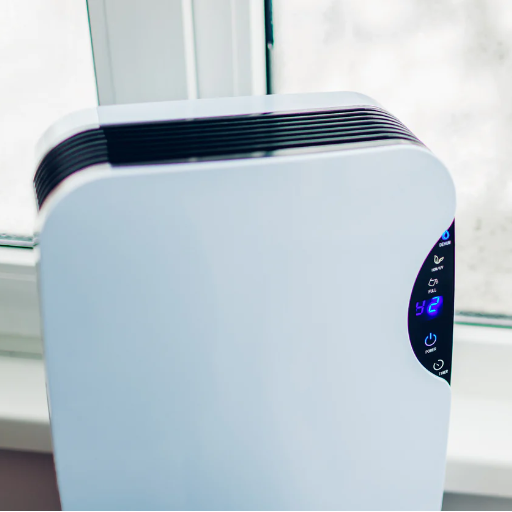
A portable dehumidifier solves the multi-course problem of excess moisture in the air. First, it employs a fan and takes in people’s breath and hot air. The air is then passed over cooled coils, which is essentially moisture. Due to the temperature difference, the moisture condenses into water droplets. This water collects in a reservoir or is drained with a hose while a dehumidifier blows the cleaned dry air indoors. This cycle will run, and indoor humidity levels will eventually drop to the desired levels.
The process of condensation in dehumidifiers
In essence, condensation permits dehumidifiers to get rid of moisture-laden air indoors. During airflow, warm, wet air is drawn in with the help of a fan, which is an evaporator with quite a cold coil, which is well-designed in great detail. These coils are developed in such a way that the temperature of the air is lowered even below the dew point, a point between gas and liquid water. Once water vapor condenses on these surfaces, it is either allowed to drip into a small tank located within the unit or prevented by a drainage system. The moisture is then evaporated off using coils to retain dry air and release it into the surroundings. This approach reduces humidity or moisture content in the environment, preventing mold growth, lowering allergens, and increasing the quality of life. The dehumidifier works effectively under different geographical conditions because of the highly specialized refrigeration technology responsible for this.
Refrigerant vs. desiccant dehumidifiers: How they work
Both desiccant and refrigerant dehumidifiers employ different methods while still serving their core purpose, and each can be used in other circumstances. To begin with, refrigerant dehumidifiers remove liquid condensation from air vapor by taking air into cold evaporator coils. This method works well in hot, humid areas but fails to do so in cold weather. In what might be considered the inverse of refrigerant dehumidifiers, desiccant units place moisture-absorbing materials such as silica gel inside the device, allowing for energy-effective air cooling and precise humidity control in low temperatures. Despite desiccant units using more energy, they work well in complex conditions.
The role of fans and coils in moisture removal
Dehumidifiers have fans and coils essential for removing moisture from a space. The fan draws humid air into the system and blows it through the evaporator coils on the cooler side. Depending on the structure of the coil, the dew point can be executed to remove the moisture in the air being pumped in. As the dew point is achieved, moisture condenses on the coil and is routed into a drainage system or aquarium. The humidity within the air is removed, and when it goes over the condenser coil, it gets reheated and is released back into the atmosphere. It can be said that this operation not only manages the air’s humidity levels but also provides a distinct advantage by allowing more airflow and moisture absorption from the air, making the surface of the space dry. Moreover, an essential factor to this system’s function is maintaining a balance between the calibrated speeds of the fan and the coils, which allows for smooth facilitation of airflow.
What are the key components of a portable dehumidifier?
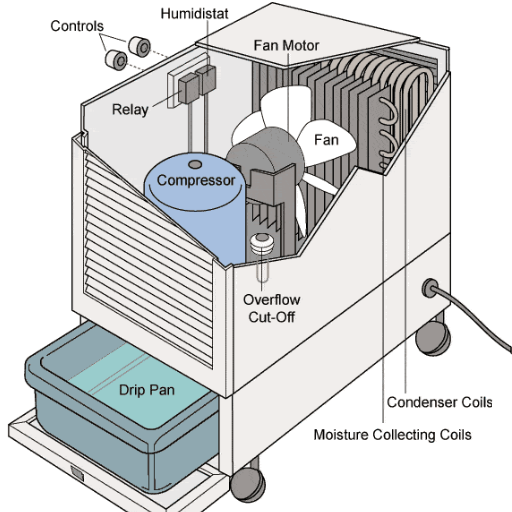
A portable dehumidifier has several key components that effectively control humidity levels in a given environment. First, the compressor is a critical component that powers the refrigeration cycle and, as such, the cooling coils responsible for moisture removal. Second, heat removal processes must place the evaporator and condenser coils in the dual interexchange. The fan serves to intake air with embedded moisture and then blows out drier air into the atmosphere. In combination, the water collection reservoir or drainage system serves to collect the water that has been changed to vapor, and the humidistat serves to check and control the humidity of the environment. Additionally, many units have air filters as an integral part of the unit that aids in ingesting dust particles and other germs suspended in the air and expels cleaner air.
Understanding the compressor and refrigerant system
A dehumidifier operates on the principles of thermodynamics and is essential in the compressor and refrigerant system working at its core. A high-level mechanical compressor condenses the gas, resulting in high temperatures and pressure. This means the cylindrical piece compressing the refrigerant gas will have room temperature and pressure pouring into it. This, in turn, aerates and cools and then gets transmitted through the evaporator coil. Vapor condensation is around a specific temperature with this chilled liquid, meaning condensation is inevitable as it converts low-temperature gases to liquid-state air.
Heat exchangers in the compressor system effectively reduce humidity. The refrigerant’s effectiveness is essential for stabilizing the indoor temperature and maximizing energy efficiency, making its integration with the compressor valuable.
The importance of the collection tank and drainage options
One of the most daunting tasks of a Dehumidifier is moisture removal, which is why using a collection tank is recommended for easier emptying. Collection tanks with smaller capacities require frequent emptying, making operations highly inefficient in humid environments. Using a drainage hose or connection of the tank to a pumping system is a highly advanced technological feature as it allows the tank to be drained continuously without additional manual effort. Dehumidifiers are extremely helpful in controlling moisture, such as removing moisture, which is essential while cutting off humidity. Using durable drainage systems alongside accurately sized collection tanks enhances unit efficiency and extends its life span. While purchasing a dehumidifier, the tank size and drainage features must be considered as, in most cases, capacity requirements fluctuate based on how humid an environment is.
Control panel and humidity sensors explained.
Integrated control panels and humidity sensors on a dehumidifier facilitate better machine usage while increasing accuracy. These sensors can detect the amount of moisture in the air and then automatically tweak the device to the appropriate settings to achieve the required percentage. This, combined with modern upgrades, ensures the smart device uses energy efficiently while maintaining suitable conditions in homes and businesses.
How does a portable dehumidifier differ from a whole-home dehumidifier?
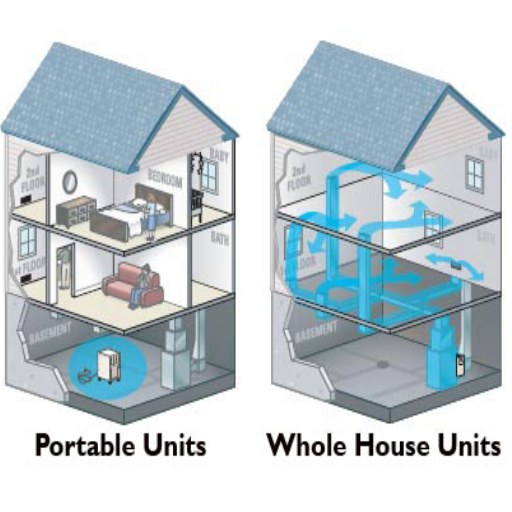
Portable dehumidifiers are typically easy to carry and install. They are meant to control moisture in specific rooms, such as basement bedrooms, dealing with humidity in targeted locations. On the other hand, whole-home dehumidifiers are fully integrated into buildings’ heating systems, allowing them to control humidity levels throughout a house. These devices are more powerful and effective but often require trained professionals to install them and are more expensive. Choosing between the two devices depends on the scale of the humidity issue.
Comparing portable and whole-house dehumidifier systems
The definitions of whole-house humidifier and portable are entirely different entities, ranging from expenses to ease of installation, upkeep, and capacity. Portable dehumidifiers are stand-alone appliances used on a targeted basis for addressed areas, rooms, and any designated space. In contrast, whole-house humidifiers can be understood as dehumidifiers suited to be installed across the home without any designated area. These are also considered more efficient humidifiers.
When considering the whole-house approach, one must consider the dangers of owning a traditional portable humidifier that drains the water and delves into an endless maintenance cycle. It’s fair to say that a portable humidifier is much simpler and more cost-efficient than a whole-house humidifier. Although they can keep a room less humid, they fail to maintain the humidity across a home. Whole house humidifiers integrate with HVAC (Heating, ventilation, and air conditioning), which allows the dehumidifier to provide multifunctional settings for all the rooms within the home. However, portable humidifiers are constantly at risk of excess water accumulation, leading to maintenance costs and mold. I recommend purchasing a whole-house humidifier if you have a bigger house while considering the long-term air quality management plans.
Pros and cons of portable vs. HVAC-integrated dehumidifiers
Both portable and HVAC-integrated dehumidifiers have pros and cons, and my usage informs me that I can deploy each to a pool of requirements as needed. A portable dehumidifier works on a significant moisture issue existing in one room, and the most considerable factors enabling this are the ease of installation and the relatively low price. More often than not, however, these units require the owner to do some work, for example, emptying a reservoir or dealing with sound generated in workplaces where space is an issue.
On the flip side, HVAC-integrated humidifiers do a fantastic job with whole-house problems, as they help control humidity levels with the combination of the AC unit that is being used. Such units are more efficient at enhancing air quality and lowering the risks of mold growth. The HVAC unit can control the indoor temperature and humidity simultaneously. However, their disadvantages require them to be more expensive than the rest, have a complex structure that deploys them to need specialists to install them, and require the user to spend a lot to maintain the implant. If budget is not a significant issue, the scope of the problem that needs to be focused on and how easy the solution is should inform the evaluated decision that needs to be reached.
Can a portable dehumidifier improve indoor air quality?
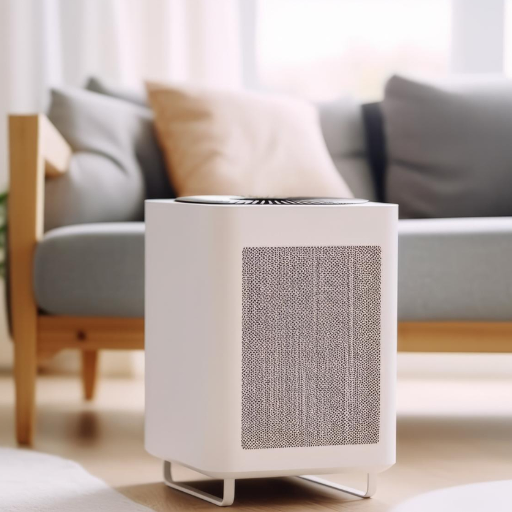
A personal dehumidifier or mini dehumidifier can be beneficial for indoor air quality as excess moisture is removed, preventing the growth of mold and dust mites. It also reduces the allergens and helps those with respiratory issues breathe by regulating humidity. They are affordable, convenient, and effective in controlling moisture, but only effective in a localized area of use. However, they only work in the area they are placed in, and other regular maintenance, like emptying the water tank and cleaning the filters, is essential.
Effects of dehumidification on dust mites and allergens
Lowering indoor humidity levels below 50% prevents dust mites and other allergens from existing indoors. This shows that dehumidification has a significant role in reducing the presence of dust mites. Mites mainly feed off moisture in the atmosphere as opposed to water. Therefore, their life cycle is adversely affected by a lower humidity level. Another common allergen is mold spores, which do not readily form or spread when controlled humidity levels. When airborne allergens are exposed to higher humidity levels, they increase and, in turn, affect the indoor air quality negatively. Indoor allergens can be controlled while minimizing allergic responses to lessen indoor humidity. As a result, cleaning ventilations regularly, along with using dehumidifiers, reduces allergen levels and creates a positive living space.
How dehumidifiers help prevent mold and mildew growth
Suppression of indoor humidity levels will significantly prevent mold and mildew growth, which is a dehumidifier’s most significant assistance. Indoor mildew and mold spores flourish in a relative humidity exceeding sixty percent. Dehumidifiers curb excessive moisture in the air and help cultivate an environment where fungi are unlikely to grow. And, of course, using a dehumidifier when working in moisture-hygienic environments such as a basement, bathroom, or deep freezer stops moisture accumulation, further reducing bather mold on visible or non-visible surfaces. Structural materials are not the only beneficiaries, as the ambient air quality improves significantly.
How do I choose the right portable dehumidifier for my space?
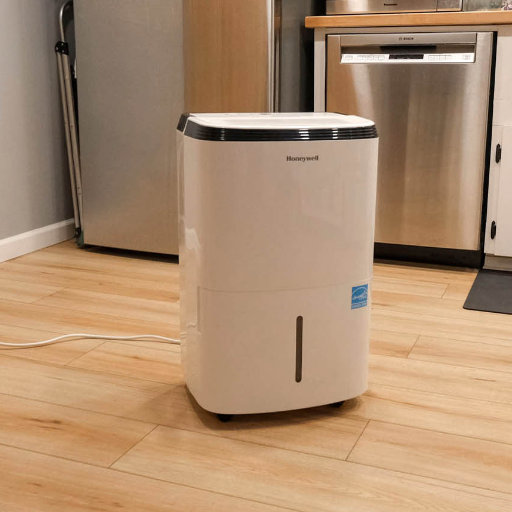
To determine the capacity of the portable dehumidifier, consider the size of your room because it often indicates the number of pints drawn. The range includes small sizes for compact spaces with temperatures, while larger rooms or overly damp environments increase the demand for large units. Then, look for adjustable humidity levels available within the temperature range, energy efficiency certificate, and ease of servicing, such as the position of water reservoirs and drainage that allows gravity flow. Depending on its location and frequency of use, noise levels and the weight and dimension of the dehumidifier’s built-in wheels or handles can also be parameters of importance.
Understanding dehumidifier capacity and room size
To choose the appropriate dehumidifier, the unit is designed according to the size of the room and its moisture level. The standard way of categorizing units is according to their effective sizes and the number of pints that can be extracted within a day. A 20-30 pint capacity dehumidifier suffices For bathrooms or smaller bedrooms up to 300 sq ft. Living rooms or basements up to 500 square feet have a recommended range of 30-50 models. However, for larger or more damp areas with square footage of 1000 and above, a 50-pint model is recommended.
With the room dimensions, the humidity level also plays a key role in your selection. A lower range of the unit could work with slightly damp spaces, but a higher capacity unit is the better option for areas with higher humidity or moisture levels. Remember to always keep room-specific variations in mind, such as climate or ventilation of the room, to conclude which dehumidifier is suitable.
Key features to look for in portable dehumidifier models
Below are some of the features I have considered while evaluating portable dehumidifier models for efficient operation and ease of use. To begin, adjustable controls for humidity are crucial as they allow me to remain as precise as possible by maintaining the desired set humidity level. Second, a built-in hygrometer and a humidistat are helpful as they display current humidity levels, enabling greater precision. Third, I check if the devices have high energy standards, such as an ENERGY STAR certification, as that would reduce long-term energy costs. Other functional aspects of the portable dehumidifiers that I prioritize include large water tanks with an auto shut-off feature to avert overflows, constant draining facilities for convenience, and lightweight, portable models with wheels for more effortless movement. I also consider the noise levels produced by the materials and use quieter ones to avoid the noise.
Energy efficiency considerations when selecting a dehumidifier
Dehumidifiers with the ENERGY STAR label should be your focus when assessing their energy consumption. An ENERGY STAR certification suggests the product meets the energy, efficiency, and environmental sustainability requirements. Such products also use less energy than the non-certified ones, reducing their ecological and running expenses. Check the rated power and the rated power of the device; the higher the moisture removal capacity per kWh, the better the dehumidifier. After that, look for features such as programmable timers, multiple fan speed settings, and humidity sensor control, which increase the appliance’s efficiency and reduce electricity wastage. There may be no extra energy cost of continuously running these appliances when connected to a dehumidifier equipped with continuous drainage and located in areas with large capacities. All those factors will aid you in looking at cost-effective moisture control methods.
How does a portable dehumidifier compare to an air conditioner?
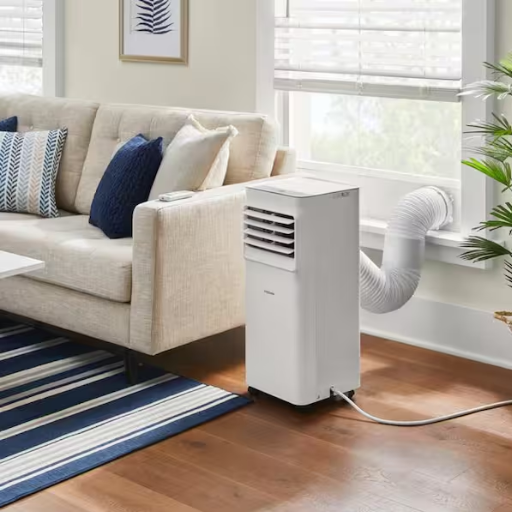
While portable dehumidifiers and air conditioners have certain overlapping functions, they are designed to achieve different objectives. A portable dehumidifier’s main task is to remove excess moisture from the air to lower humidity and enhance indoor air quality by preventing mold growth. On the other hand, an air conditioner has the primary objective of removing heat from the room, along with a secondary switch-on function for humidity control. Anyway, moist air has permanently been easily removed by coolers or air conditioners, though dehumidifiers are more effective, particularly in moderate heat where cooling is unnecessary. Furthermore, dehumidifiers are affordable and compact and use less energy in moisture control because they do not require temperature adjustments.
Dehumidifier vs. air conditioner: Key differences in functionality
The core functions of the two devices are the most significant difference that separates a dehumidifier from an air conditioner. The sole purpose of a dehumidifier is to remove excessive humidity from indoor air by maintaining it at an ideal level of around 30-50%. This process improves the air’s quality and stops mold and mildew development. An air conditioning unit, however, works inside air ducts or windows to remove heat and thus lower the temperature of air that would otherwise close a room, there being no intent to remove humidity, though that is what would happen. When employed to remove all or most of the moisture in the air in a room, though, specialized dehumidifiers would be less effective in such settings.
In an instance where cooling is not required, a dehumidifier is a suitable choice since it removes excess humidity and does not considerably decrease room temperature. Conversely, air conditioners use higher energy to cool the air and reduce moisture. In addition to this, air conditioners are bulky and complex, needing the installation of external venting systems, while dehumidifiers are portable. The choice between the two needs to be made on whether the main aim is temperature reduction or having a precise humidity level since neither of the products can function entirely as the other does.
When to use a dehumidifier instead of an air conditioner
Whenever the need to eradicate unnecessary humidity arises without regard to the temperature, one should reach for a dehumidifier instead of an air conditioner. For a damp room or a space that requires a controlled temperature throughout winter, a dehumidifier is undoubtedly the more energy-efficient and cost-effective choice. Compared to air conditioners, dehumidifiers are highly user-friendly and allow for greater portability, making them a better choice for targeting a specific humidity level.
Combining dehumidifiers with air conditioning for optimal comfort
Utilizing dehumidifiers with air conditioners simultaneously addresses temperature and humidity control, enhancing indoor air quality and comfort. It is accurate to say that air conditioning units have a functional limit on the amount of humidity, which is controlled since, in the process of cooling, some moisture is bound to be eliminated. However, it is critical to maintain a dehumidifier to avoid issues such as mold formation, smoke dust, allergens, and dampness.
For best results, it is recommended that you use a dehumidifier alongside your air conditioning system in hot and humid rooms, like attics or basements, or even the first floor of your home. Such vice versa aids the air conditioner in functioning in a better way since it lessens the stress from the humidity, resulting in better energy efficiency and ultimately leading to a better life span for the appliance. To achieve the best indoor air quality, use a suitable-sized appliance relative to the room and its climate. Additionally, factors such as upkeep, changing the filters and monitoring humidity levels may enhance the functioning of the devices.
References
Frequently Asked Questions (FAQ)
Q: How does a dehumidifier work to remove moisture from the air?
A: A dehumidifier draws in warm, humid air and passes it over cold coils. As the air cools, the water vapor condenses on the coils. This condensed water is collected in a tank or drained away while the now-drier air is heated slightly and released back into the room. This process effectively reduces the relative humidity in your home.
Q: What are the different types of dehumidifiers available for home use?
A: There are several types of dehumidifiers for home use, including refrigerant (compressor) dehumidifiers, desiccant dehumidifiers, and whole-home dehumidifiers. Refrigerant dehumidifiers are the most common and use a process similar to air conditioning. Desiccant dehumidifiers use a moisture-absorbing material, while whole-home dehumidifiers integrate with your HVAC system to dehumidify your entire house.
Q: What are the primary uses of a dehumidifier in a home?
A: Dehumidifiers have several uses in a home. They can help reduce excess moisture, prevent mold and mildew growth, eliminate musty odors, protect furniture and belongings from moisture damage, and improve overall air quality. Dehumidifiers can also make your home feel more comfortable by reducing humidity and making warm air more fabulous.
Q: How do I know what kind of dehumidifier I should get?
A: Choosing the right dehumidifier depends on several factors. Consider the space size you need to dehumidify, the average humidity level in your area, and any specific moisture issues you’re facing. A whole-home dehumidifier with your HVAC system might be best for larger spaces or whole-home solutions. For smaller areas or portability, a standalone unit might suffice. Also, features like automatic shut-off, digital controls, and energy efficiency ratings should be considered.
Q: Can a dehumidifier help with allergies and respiratory issues?
A: Yes, a dehumidifier can help with allergies and respiratory issues. By reducing excess moisture in the air, dehumidifiers create an environment less favorable for dust mites, mold, and mildew – common allergens that thrive in humid conditions. This can improve air quality inside your home, potentially alleviating symptoms for those with allergies or respiratory conditions.
Q: How does a whole home dehumidifier differ from portable units?
A: A whole-home dehumidifier is integrated into your home’s HVAC system and works to dehumidify the entire house. It’s typically more powerful and efficient than portable units and can handle larger spaces. Portable dehumidifiers, on the other hand, are standalone units that can be moved from room to room as needed. They’re ideal for targeting specific areas or homes without central air conditioning systems.
Q: How often should I empty the water tank of my portable dehumidifier?
A: The frequency of emptying your dehumidifier’s water tank depends on the humidity level in your home and the tank’s capacity. Many dehumidifiers have an automatic shut-off feature when the tank is full. Generally, check the tank daily in humid or moderately humid environments every few days. Some dehumidifiers also offer a continuous drain option, eliminating the need for manual emptying.
Q: Can a dehumidifier help cool a room?
A: While a dehumidifier doesn’t directly cool the air like an air conditioner, it can make a room feel cooler. By removing excess moisture from the air, a dehumidifier reduces the humidity level. Lower humidity makes it easier for sweat to evaporate from your skin, which is your body’s natural cooling mechanism. This can make the room feel more comfortable, even if the temperature hasn’t changed.


